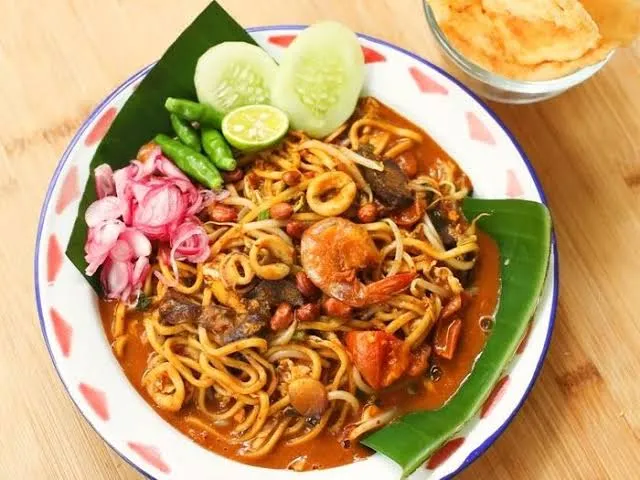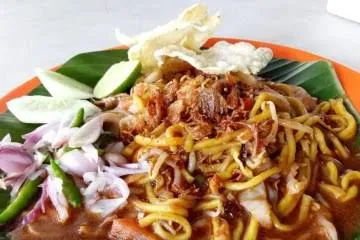I will tell you my traditional food .. Aceh . Aceh noodles . how to make it and the benefits for our body



Aceh Noodle Soup Ingredients:
- 500 grams of yellow noodles
- 5 red onions, thinly sliced
- 4 cloves of garlic, thinly sliced
- 1 tomato, chopped
- 100 grams of cabbage, finely sliced
- 50 grams of bean sprouts, cleaned
- 1 celery stalk, thinly sliced
- 1 medium crab
- 150 grams of beef, diced
- kg shrimp
- 750 ml of broth
- 1 bay leaf
- 4 tablespoons of cooking oil
- 2 tablespoons of sweet soy sauce
- 2 tablespoons soy sauce
Softened seasoning:
- 5 red onions
- 4 cloves garlic
- 3 pieces of red chili
- 1 cm turmeric
- 1 cardamom
- 1 teaspoon pepper powder
- teaspoon coriander
- teaspoon cumin
- Salt to taste.
Supplementary Material:
- Pickled cucumber
- Chips
- Fried onions.
Ways of making:
- Preheat the cooking oil and fry the sliced red onion, garlic and spices until fragrant and cooked.
- Enter the meat, cook until the color changes.
- Add broth, shrimp, and crab.
- Enter the bay leaf, salt and pepper powder.
- Cook until meat, crab and shrimp are cooked.
- Enter the bean sprouts, cabbage and tomatoes as well as sweet and salty soy sauce.
- Stir well until all ingredients are evenly mixed.
- Lift and serve
Aceh noodle ingredients
In processed Aceh noodles, there are so many nutritional content contained in it such as carbohydrates, proteins, vitamins and so on which are very good for consumption by the body as long as it is not too excessive. For that, let's look at some of the ingredients that contain more nutrition and are good for health in Aceh's noodle culinary.
*Yellow Noodles*
Yellow noodles in Indonesia are generally made from flour, in which there are 71.3 grams of carbohydrates, 476 kilocalories, 0.1 grams of protein, 57 milligrams of calcium, 36 milligrams of phosphorus and 4.8 milligrams of iron. The carbohydrate content in noodles is the highest nutrient so that it can be classified as a staple food or main energy producer. if you don't have time to eat rice, then noodles can be an alternative food to replace rice because it can help meet nutritional intake and help the stomach to be full.
*Shallot*
In the medical world, onions are believed to be able to fight cancer and various other dangerous diseases. Shallots have very high nutrients such as vitamins, minerals and antioxidants and are low in calories, so they are often used as a mandatory cooking spice. Besides being useful for cancer prevention, red onions are also good for the heart, diabetes medicine, prevent inflammation of the throat, regulate mood and increase appetite.
Garlic
Allium sativum or the name we often know as garlic is a type of plant that is very often used as a kitchen utensil in the Asian region. In countries such as Japan and China, garlic is believed to be able to eliminate various diseases such as removing toxins in the body, preventing cancer, healing skin wounds, anti-inflammatory and overcoming diabetes. Garlic per 100 grams contains nutrients such as carbohydrates of 33.06 g, protein 6.39 g, vitamin B6 1.235 mg, energy 623 kj, calcium 181 mg, etc.
*Turmeric*
Turmeric has many benefits when consumed by the body, because these foods have 63 kilocalories, 2 grams of protein, 9.1 grams of carbohydrates, 24 milligrams of calcium and vitamin A. Turmeric is very useful for health because it can prevent aging, antidepressants, cholesterol drugs, treat typhus, prevent anemia, improve digestion, prevent alzheimer and anti-inflammatory drugs.
*Red chili*
The nutritional content of fresh red chilies is 7.3 g of carbohydrates, 31 kcal of energy, 470 IU of vitamin A, 24 mg of phosphorus, 29 mg of calcium, etc. Red chili also has many benefits such as helping the process of digestion of food, speeding up bringing fresh blood to the area of infection, reducing the risk of colon cancer, and increasing the metabolic pathway.
Bean sprouts
Bean sprouts or sprouts are seeds that are very often served in Indonesian specialties. Usually bean sprouts are cooked by sautéing, and Aceh noodles are also one of the dishes that use bean sprouts as an ingredient. Sprouts contain a lot of nutritional content such as vitamins A, B complex, C, E, as well as calcium such as fiber, calcium, potassium, iron, magnesium, amino acids and protein. Bean sprouts are good for consumption because they can prevent heart attacks, strengthen bones, increase immunity, skin beauty, improve digestion, and prevent cancer.
*Cabbage"
Cabbage, also known as cabbage, is an important source of vitamins, minerals and dietary fiber. The benefits of cabbage for health in the form of antioxidants, boosting the immune system, caring for the skin, preventing constipation, reducing the risk of cataracts, etc. In every 100 grams of cabbage, the nutritional content contained therein can be in the form of vitamin C of 36.6 mg, calcium 40 mg, magnesium 12 mg, potassium 170 mg, protein 1.28 g, carbohydrates 5.8 g, sugar 3.2 g. , etc.
*Celery*
Celery is a flavor enhancer leaf that is often used for flavoring food. Celery leaves are very rich in vitamins such as vitamin A, vitamin B1, vitamin B3, vitamin B5, vitamin B6, vitamin C, vitamin E and vitamin K. Diseases that can be prevented by consuming celery leaves include preventing asthma, anemia, and obesity, strengthens liver function, aids in dental repair, soothes nerves, and slows down premature aging.